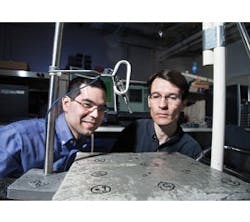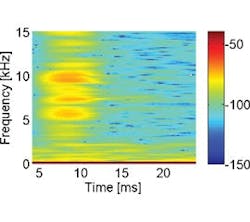BRIDGE RESCUE: Wetting the decks for inspection
Two professors at Brigham Young University have been pushing the burgeoning field of acoustic impact-echo testing for bridge damage inspections in interestingly “liquid” directions.
Bridge decay is not always, or even often, apparent to the naked eye. By the time a pothole appears, significant degradation has occurred within the concrete deck; the pothole itself, while a manifestation of the deeper problem, is but one result of more insidious issues. In most of the U.S., chloride-based deicing salts are applied to driving surfaces in enormous quantities throughout the colder months, and over time these salts’ chloride ions leech their way into the concrete, where they accumulate around the embedded reinforcing steel rebar, causing rusting of the metal. As rust is significantly greater in volume than the steel on which it feeds, the resulting corrosion leads to the development of subsurface cracks and fissures within the concrete, or delaminations. For nearly three decades, researchers in disparate corners of the U.S. have been looking into methods of inspecting bridges that marry accurate results with minimally invasive and rapid processes. The standard methods of pulling a net of chains over the deck or issuing sequenced hammer strikes in order to collect internal echo response vibrations are both inordinately time-consuming and present a potential further threat to bridge integrity.
Enter Dr. W. Spencer Guthrie, professor of civil engineering at Brigham Young, and his ongoing research into alternative and sustainable methods of acoustic impact data retrieval.
“My research has focused heavily on management of concrete bridge decks,” Guthrie, who has been on BYU’s faculty since 2002, told Roads & Bridges. “Effective bridge-deck management requires an understanding of how bridge decks deteriorate, which in turn requires methods of assessing the degree of deterioration. Methods of assessment that provide reliable data to bridge managers are needed to enable them to make sound technical decisions that extend bridge life while minimizing costs. My interests are directly tied to helping bridge managers accurately assess the condition of bridges so that they can apply the right treatments at the right time, thereby using the available resources in the most efficient ways possible.”
Dr. Brian Mazzeo, professor of electrical and computer engineering at BYU, to whom Guthrie reached out in order to solve an issue with electrical impedance measurements in concrete, found himself in the midst of a surprising problem.
“I was astounded that [inspectors] were dragging chains and tapping with hammers to find delaminations,” Mazzeo told Roads & Bridges. “Because of my background in electrical engineering, this area of testing seemed ripe for new methodologies and algorithms that could be deployed quickly and efficiently to scan large areas and create defect maps.”
Eschewing the standard methods, Mazzeo and Guthrie’s joint work thereafter utilized various alternative substances in order to gauge what type of substance could meet the criteria of speed, reproducibility and low-impact.
The path to these substances was not entirely, however, one of design. Felicity played its part, too.
“One late night in the laboratory I was dropping various things like metal balls, pellets and other things on a piece of delaminated concrete and listening to responses,” said Mazzeo. “I got a beaker of water and poured it onto the delaminated region and heard a distinct response. You might say the first studies we performed were somewhat serendipitous.”
The availability, relative lack of expense and environmentally friendly characteristics of water made it an interesting path of pursuit. In laboratory application, the team pumped water through a 6-mm tube at a height of 2 meters above the deck, and used a microphone connected to the impact site by tubing to record the impacts. An acoustic sampling unit analyzed the sound waves, processing a pattern of wave responses that indicate the degree of delamination. The data produced by spectrograms of frequency over time showed definite, low-frequency echoes from buried structural imperfections in the deck.
“Water works,” said Mazzeo, “because of a phenomenon known as the ‘water hammer’ effect, which is what produces a small shock wave when a water droplet strikes a surface. The momentum transfer from the droplet can also excite the flexural response of thin delaminations.”
With laboratory results promising, the researchers undertook physical experimentation in the field.
In and out of the lab
“We completed a project for the Utah DOT,” said Guthrie, “in which we tested a comparatively large bridge deck with a surface area of nearly 40,000 sq ft.”
Cheryl Hersh, structures design manager for UDOT, coordinated the project. “We basically wanted conditions analysis on a bridge deck to see what the status was and how results could be gotten, and approached the BYU team for assistance. They supplied the [water] methodology.” UDOT then provided traffic-control assistance.
“Because of high traffic volumes during the day, we performed the work at night,” said Guthrie. “We collected both acoustic impact-echo data and chaining data to enable direct comparisons of the methods. Taking something from controlled laboratory conditions to making maps of bridges in the field required a significant engineering effort . . . Our equipment had to roll over many miles to complete the project and automatically recorded and algorithmically processed thousands of impacts.”
And what did the team learn? “Unfortunately, it seems like water as an impactor is limited in exciting modes associated with deep delaminations in concrete,” said Mazzeo, despite its success with shallow delaminations. “Water was a good starting point. However, we are moving forward with some other impactors.”
Mazzeo and Guthrie’s research then turned toward solid materials. Paintballs presented an interesting medium. Their surface is tensile relative to water droplets, and their liquid inner spheres led the pair to posit that excitation could be realized and measured with a degree of confidence for deeper defects in the concrete. Concurrently, the team began to develop new computer algorithms for analyzing the acoustic impact-echo data they were generating.
Brigham Young University laboratory set-up for paintball experiment. The pellets were fired from the suspended gun and their impacts were picked up by ultrasonic microphone (right of picture, taped to the crossbeams).
“There is a lot of work to be done on quantitative interpretation of impact data,” said Mazzeo. “[Some] signal processing magic is required to take acoustic responses and estimate damage. We want to make sure that the maps we generate are verifiable and reliable.”
The pair utilized a section of decommissioned bridge deck, which had been in place since 1937 and recently removed from I-15 in Utah. This platform was ideal, as it presented with naturally occurring delaminations at several levels. Paintballs were then dropped gently (so as to remain intact) onto both the decommissioned deck surface and a control surface from a few inches, while their impacts were recorded by an ultrasonic microphone and subsequently analyzed. Analysis showed that there was more resonant energy associated with impacts on the delaminated surface than on the intact surface.
Need for speed
“We were particularly interested in the ability to dispense paintballs in rapid succession and thereby enable rapid testing,” said Guthrie. “We performed many tests in the laboratory and have also had the opportunity to conduct limited investigations in the field.”
Thus, a second series of experiments were undertaken whereby paintballs were impacted rapidly (via a gun) and with force enough to rupture their membranes. Results showed that the acoustic impact recording was mitigated by the room-echo sound of the gun firing, renewing the researchers’ acknowledgment that impact response is influenced by several factors, including speed, the mass of the substance and the impact ratio.
“We wanted to investigate the parameter space involving high-speed impacts [with] the paintball approach,” said Mazzeo, adding wryly, “As you might imagine, it also turned out to be quite a bit messier than one might hope for a technology to be deployed on bridges in the field.”
A comparison of low-velocity paintball impact spectrograms; image A (left) shows the impact result on intact concrete; and image B (right) shows the result on delaminated concrete. The scale is in dB. Note the significant change in the low register reading in image B.
While the data from both sets of experiments suggests that the application of paintballs does generate impact-echo responses commensurate with the existence of delaminated areas within concrete, Guthrie said, “further research is needed to more fully develop this particular application.”
The public dimension
So, why focus their research on this particular area in the first place?
The public dimension, said Guthrie, was, and remains, a major propeller of their cause. “A significant challenge affecting bridge-deck condition assessment is minimizing the impact of the testing on the traveling public. Many assessment methods require physical testing of the deck, which necessitates inconvenient lane closures that inevitably cause delays in traffic. We have made deliberate efforts to increase the speed of data collection while still allowing appropriate resolution, and our goal is to increase the speed to the point that data collection without lane closures may be possible in many instances.” Additionally, environmentally benign impactors were an attractive aspect to the work, due to their ability to be dispersed readily, not require retrieval, and not be a danger to the travelling public.
With the ultimate goal being large-scale deployment of automated scanning technologies, Mazzeo and Guthrie continue to press forward in their research, seeking alternative substances and methods to “bridge” their theories of inspection methodology from the controlled environment of the laboratory to the bridges and byways of Utah—and eventually countrywide.
“Developing an automated impact-echo testing device is an important objective of our research,” insisted Guthrie. “We will absolutely continue to study [these] methods and their applications to concrete bridge-deck management.” R&B



